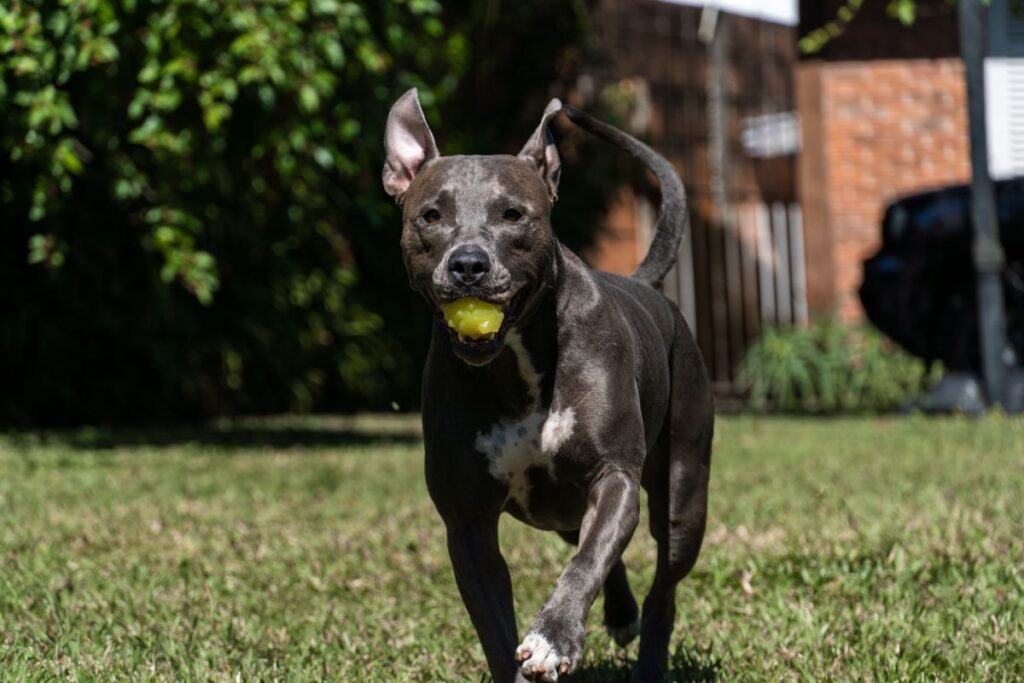Reviewed by: Dr. David Tittle, BVetMed, CertVA, GPCert(WVA&CPM), MRCVS
Just hearing the name ‘pit bull’ can conjure up a variety of images and feelings for people. Some see a loyal, friendly companion, while others envision an aggressive fighter. Of course, the truth lies in the fact that every dog is different and is a combination of both their genetic predispositions and their individual personalities.
The pit bull is actually not a breed recognized by the AKC because, instead of being a separate breed, it is a category of dog with similar characteristics, like ‘hound’ or ‘terrier.’ Pit bulls can be the results of cross breeding or purebred dogs. They can be versions of American Pit Bull Terriers, American Staffordshire Terriers, or a mix of both breeds.
The Blue Nose Pit Bull, recognizable by its blue-grey colored nose and coat, is not a distinct breed within the pit bull category. Rather, these dogs are the results of a genetic variation where the recessive gene that suppresses melanin production is expressed and dilutes the amount of color produced in the hairs, similar to the way some people have blonde hair.
They are often referred to as a ‘rare breed,’ but the odds of having blue nose puppies are increased by breeding two parents who carry the blue nose gene. Unfortunately, as these dogs have become more popular, some unscrupulous breeders are mating dogs just for the appearance of the puppies that will result instead of carefully considering the health of the breeding lines.
Table of Contents:
History
The dogs we recognize as pit bulls were originally bred in England in the early 1800s. Bear baiting and bull baiting were popular entertainments where dogs would be placed in a ring to torment a bear or bull for hours by biting its face and nose until the bear or bull collapsed from exhaustion and was killed. The best dogs for this ‘sport’ were Old English bulldogs who were renowned for their strong jaws, muscular, low-slung bodies, stamina, and unwavering determination.
After this practice was ended by the passage of the Cruelty to Animals Act in 1835, people began using dogs in competitions called ‘ratting’ where they would put a number of rats in a pit and see how many a dog could kill in a certain amount of time. To be successful, the dogs needed to be not only strong and determined but also fast and agile, so people began breeding terriers with bulldogs. The dogs that resulted were known as Pit Bull Terriers. They were favored for ratting and later dog fighting, but handlers were careful to train them not to bite humans.
In the mid-1800s, English settlers brought their pit bulls to America, and the dogs they began breeding were known as American Pit Bull Terriers. These dogs were sought after by ranchers and other early settlers of the American west. They were seen less as fighting dogs and instead were respected for their skill in herding sheep and cattle, while also being good guard dogs. Their popularity as both working dogs and guard dogs, as well as family companions continued to grow into the 20th century, and they were celebrated during World War I and WWII for their bravery and loyalty on the battlefield, so much so that they were used in wartime advertisements as mascots supporting the war effort.
Sergeant Stubby was a famous pit bull who served in WWI and was highly decorated for his bravery during 17 battles. He saved many soldiers by alerting them to incoming munition fire before the humans could hear it, which allowed them to find shelter before being hit. Stubby is the only dog to have earned a promotion to sergeant based on his wartime service.
The popularity of American Pit Bulls continued to grow after WW1, and they quickly became popular companions to celebrities and politicians. President Theodore Roosevelt, Mark Twain, Thomas Edison, and Helen Keller are a few of the famous people at the time to have pit bulls, and they were sought after companion pets for the next few decades.
Even though Congress had outlawed dogfighting in the mid-1970s, it began to re-emerge in the 1980s. Pit bulls were again being bred as fighters, and the public started to see them as vicious companions to criminals and violent gangs. A lack of early socialization and training to be fighters gained them the reputation of being violent dogs not suitable to be home companions. This perception of pit bulls led cities across the United States to create breed specific legislation (BSL). Most often focused on pit bulls, BSL in cities ranges from laws that ban the breeding of pit bulls to labelling the entire breed as ‘dangerous’ or ‘vicious’ to mandating that all pit bulls be spayed or neutered. Some landlords and insurance companies will not allow pit bulls. Because of these laws and as a result of poor training, they became the breed most frequently surrendered to shelters, and as they were thought to be impossible to re-home, they were frequently euthanized.
It is becoming steadily more common for pit bulls and pit bull mixes to be seen once again as the loving, loyal family dogs that they can be. A conscientious breeder, who takes into account personality traits as well as physical ones, proper socialization, and training are keys to any dog’s success, and pit bulls are no different.
Appearance
The blue nose pit bull is a muscular, medium sized dog. They usually weigh between 30- 60 pounds depending on their sex and breed. They have a powerful, stocky stance, an angular wide head with a short muzzle, and round or almond shaped eyes.
The blue nose pit bull is especially notable for their blue grey nose and matching coat coloring that may have patches of white. They have short, smooth, glossy fur that feels stiff. They can have brown, green, hazel, or blue eyes. Often, puppies born with blue eyes will undergo a change as they get older.
Personality
When raised correctly, the blue nose pit bull is a great companion dog. They are intelligent, friendly, loyal, and affectionate, and they get along well with family members of all ages. Blue nose pit bulls are easy to train because of their positive energy and willingness to work hard, but they can be a bit headstrong and want to get their own way.
Blue nose pit bulls are athletes who need an active run around or walk every day. An active person or family will soon find they have a terrific training partner in a blue nose pit bull. They are cheerful hiking, biking, or running partners. Their high intelligence makes them well-suited for ‘brain games’ like fetch, and they excel at agility work. Balancing this need for exercise, however, is an ‘off switch’ that will find them curled up in a cozy spot or happily sitting beside you on the couch.
Health
A downside in breeding for the recessive genes that create a blue nose pit bull is that some unethical breeders will overlook health concerns merely to get a litter with as many blues as possible. This inbreeding can lead to the continuance of health problems through many generations.
Like other active dogs of their size and weight, all pit bulls can be prone to hip dysplasia and patellar luxation (kneecap dislocation).
The recessive genes that give blue nose pit bulls their unique color also make them more susceptible to skin conditions, alopecia, and allergies. They might have sensitive skin and would benefit from a soothing dog shampoo and gentle brushing to help remove irritants in their fur and on their skin. Excessive scratching can lead to harming the skin, which can allow infection to set in.
They are also prone to suffer from a heart disease known as aortic stenosis. Dogs might not show any signs of this problem, so it is important to have your dog checked regularly by your veterinarian.
Grooming
The blue nose pit bull’s short, glossy coat requires little special care. They should be brushed regularly to limit shedding and to remove any dirt and allergens that could irritate their skin.
Their ears should be checked and cleaned once a week, as they are prone to ear infections, and their toenails should be trimmed as needed, once every month or so.
As dogs who love to run and dig, blue nose pit bulls can get pretty dirty and might require bathing frequently. Be sure to use a specially formulated dog shampoo that will be gentle on their sensitive skin.
Concerns
Blue nose pit bulls love to be with their people and can suffer from separation stress if they are left alone for long periods of time.
They are highly intelligent, and if they don’t get sufficient exercise for both their minds and bodies, they might turn to mischievous behavior like chewing, digging, and barking. They can be a bit stubborn and benefit from early training using positive rewards rather than punishments.
Blue nose pit bulls are powerful, active dogs, and they need to be trained to behave on a leash and not to jump on people who could be knocked over or hurt.
Due to lingering misconceptions about them being violent dogs, some communities and landlords have restrictions or bans on having a blue nose pit bull.
The Bottom Line
With their glossy blue-grey coats and noses, blue nose pit bulls get a lot of attention. Once you understand that it is unfair to say that all pit bulls are prone to violent behavior, it is clear that there are a lot of benefits to these dogs. Given a loving home and dedicated, positive training along with lots of early socialization, blue nose pit bulls make wonderful, loving, and loyal companions. They are always up for a fun romp outside and are then just as content giving a cuddle on the couch.
As always, check to ensure that you are getting a puppy from a reputable breeder who has their dogs’ best interests at heart and not just their own profits to know that you are getting a healthy dog bred to have a positive temperament.
Sources:
https://worldanimalfoundation.org/dogs/blue-nose-pitbull/
https://a-z-animals.com/animals/blue-nose-pit-bull/
https://pitbulls.org/article/blue-nose-red-nose-does-it-matter
https://www.aspca.org/about-us/aspca-policy-and-position-statements/position-statement-pit-bulls








